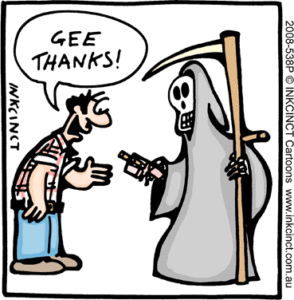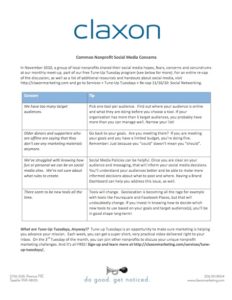
Not sure if it was the caffeine or the sunshine or some combination thereof, but we had a LIVELY discussion at Claxon’s monthly forum this morning. Here are a few of the highlights:
- Seeing a Little Red about Pink Think: October is Breast Cancer Awareness Month. Everything from NFL players’ shoes to the chocolate dipped graham crackers are pink right now. Our discussion centered around what this does from a brand perspective. How do we feel about merchants or companies who go pink for a month? Does it make us more loyal to them? The jury was out on this. The question is: what’s the impact of all this pink? In good iSector form, Komen for the Cure and other breast cancer awareness organizations have done an incredible job of raising inspiring innovation and investment, but what’s the impact? (For more on this, here’s a short piece from the Chronicle of Philanthropy and here’s a piece from Stanford School of Medicine wondering about Pink Think in 2007.)
- Newsletters: Technology is making it easier to deliver content that is tailored by participant group (a.k.a. target audience). Take advantage of it! This doesn’t take as long as you’d think. Identify your most important participant group (e.g. individual donors), create content for them, and then tailor for your other groups. Most organizations find that 75-80% of the content stays the same and it’s a matter of fine-tuning the language and the subject line. The extra effort goes a loooooong way! (If you care about kids and math, sign-up for Explorations in Math’s e-news. They have just started tailoring for different groups–and are getting a great response!)
- Detractors (a.k.a. Atheists): Yet again, we realized that we’re preaching to a lot of atheists. STOP IT!!! You can’t convert them. For every minute you spend worrying about what they think, you have one minute less to engage people who can help you advance your mission. Nuff said.
- Bums in Seats: If you’re asking staff, board, volunteers, and other fans to invite people to an event, make it 1) clear who they should invite and 2) easy for them to do so. Give them copy for an email and sample tweets/Facebook posts. Even if they don’t use the short format stuff, it will force you to whittle down your message to 140 characters and, by default, you’ll get to the essence of why someone should come. Clarity of purpose + ease of outreach=more bums in seats.
- White Whales: It’s a learned bunch that shows up for these forums and so, not surprisingly, they throw around some lofty literary references. For instance, white wales. That’s right, all organizations have white wales, just like in Moby Dick. It is that partner, that donor, that project, that funder who you try to engage (hunting sounds like you’re a stalker…not what we’re going for), yet eludes you. Every once in awhile, an opportunity presents itself where a natural connection or alliance can be made. Will you know it when you see it or will it swim passed you? Know who or what your white wales are.
So there you have it. The lively and wending discussion from this morning. We clearly had a lot of thoughts on these topics–what are yours?

 We had a blast at the
We had a blast at the 

